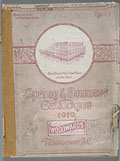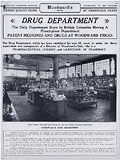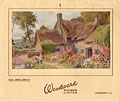|
|
| |
 |
|
| |
 Woodward's
Spring/Summer Catalogue, 1919, cover. Woodward's
Spring/Summer Catalogue, 1919, cover.
|
|
| |
|
|
|
Charles Woodward opened his first department store at
the
corner of what is now Main and Georgia Streets in Vancouver in 1892. The
catalogue,
published from 1897 to 1953, proclaimed that it was "The Great Mail
Order
House of the West." The mail-order business extended
Woodward's influence
beyond Vancouver into remote locations, particularly in British Columbia
and
Alberta. In the post-war period, Woodward's chose to expand its
chain of
departments stores rather than continue to focus on mail order.
Early Catalogues | The
Drug
Debate | Expanded Product Lines | The Great
Mail-order House of the West | Conclusion | Further
Reading
|
Early Catalogues
| |
 |
|
| |
 Woodward's
store at Hastings and Abbott. Woodward's
store at Hastings and Abbott.
|
|
| |
|
|
|
Woodward's established a mail-order department in 1896 and
published
its first catalogue in 1897. Rival David Spencer of Victoria also
introduced
a catalogue around the same time. Vancouver's population more than
doubled
in the first decade of the 1900s, from 13 700 in 1891 to 27 000
in
1901. Woodward's market included the interior and coastal BC and, in
the
Klondike gold rush era, the north.
Early catalogues contained dress goods, ladies' wear, men's
and
boys' clothing, luggage, hardware, and jewellery. These were little
more
than price lists with line drawings and, on rare occasions, photographs.
As British
Columbia's economy boomed in the early years of the 20th century
before
the outbreak of the First World War, the catalogues grew in number of
pages,
variety of goods, and production quality.
In 1902, Woodward's moved to larger premises in Vancouver's
new
commercial district at the corner of Hastings and Abbott. New departments
were
introduced. Groceries were added to the catalogues, a service that was
especially
appreciated by people living in isolated areas where supply was sporadic.
A separate
grocery list was prepared for Albertans. The spring-and-summer catalogue
proclaimed:
"Cash business is part of the success of our large and growing
business.
We keep no books, have no accountants, thereby saving thousands of dollars
to
those who patronize this store."
In 1908, Woodward's began to sell home furnishings, including
floor
coverings, and speciality goods such as religious and classical books,
stationery,
school supplies, and toys. The company stated, "We can get you
anything
you require, whether in this catalogue or not." By 1912, the
groceries
were removed from the seasonal catalogues and sold through price lists
issued
three times a year. As well as groceries, Woodward's offered food
for farm
animals, i.e., hay, oats, and chicken feed. Woodward's department
stores
were innovative, introducing a self-serve food floor and its famous
95-cent days
in 1919 ($1.49-day in 1951).
|
The Drug Debate
Charles Woodward's son Jack was a pharmacist. In 1896, he
established
a practice in his father's store that quickly became known for its
low
prices. Drugs and patent medicines were a feature of the mail-order
catalogues
beginning in 1908. The 1912 catalogue assured customers:
"Prescriptions
are all carefully dispensed by qualified druggists, any containing poisons
only
filled when signed by a qualified medical practitioner."
Woodward's
was the only department store in BC with a drug department. Druggists and
doctors
opposed the sale of drugs at Woodward's through the store and by
mail order,
a fight that lasted until the 1930s. At one time, druggists effectively
blocked
Woodward's suppliers so they had to purchase from Eaton's and
Simpson's.
| |
 |
|
| |
 Drug
Department, Woodward's Spring/Summer Catalogue, 1926, p. 29. Drug
Department, Woodward's Spring/Summer Catalogue, 1926, p. 29.
|
|
| |
|
|
|
|
|
Expanded Product Lines
A limited range of furniture appeared for the first time in the
fall-and-winter
catalogue of 1908-09. This section grew throughout the 1910s and
expanded
lines of household furnishings, such as china and glass, were introduced.
The
toy section of the catalogue, printed on pink paper, was now known as
Santa Claus's
Toyland. Hobby equipment for photographers and sports and music
enthusiasts grew
in importance after the First World War.
A large proportion of goods sold was now illustrated with either
photographs
or line drawings, but colour was not introduced until the late 1920s. At
9"
by 12" [22.82 x 30.48 cm] in size and 152 pages in length, the
catalogues
were much smaller than Eaton's or Simpson's. There was a hole
in
the corner with a string through it for hanging. Customers were advised to
keep
it handy and to "hang [it] up in a convenient place." In later
years,
Woodward's included a six-month calendar on the cover, another
reason to
hang the catalogue in a prominent place.
|
The Great Mail-order House of the West
Woodward's identified with its BC customers, boasting in the
spring-and-summer
1923 catalogue: "B.C. trade can be served best by a B.C.
store."
The company was acutely aware of the particular transportation challenges
in
the province and catered to the needs of people living in remote areas,
such
as miners, loggers, fishermen, and farmers. The catalogue gave local names
to
goods such as the "Pride of Vancouver" wood stoves
("Pride
of Edmonton" was marketed in Alberta).
Woodward's built a new department store in Vancouver in 1924 and
a second
store in Edmonton in 1926, but the Depression of the 1930s soon ended any
further
expansion plans. The company traditionally operated on a cash-only basis
but
introduced a deferred payment plan for home furnishings in 1929. There was
little
disposable cash during the Depression and competition with both local
stores
and eastern mail-order houses was tight. In 1934, 38 people were employed
in
the mail-order department, a relatively small staff. Yet, according to the
Royal
Commission on Price Spreads and Mass Buying, on 95-cent sale days, the
sales
force expanded to 500 to 700 clerks.
The Second World War again disrupted supplies and made it difficult to
guarantee
prices but Woodward's assured customers that it was providing the
best
goods at the lowest possible prices. In 1940, Woodward's introduced
the
Overseas Parcel Mail Service in support of the British war effort, a
service
it later extended to the United States, Australia, and New Zealand, and
continued
after the war into the 1950s.
|
Conclusion
Woodward's celebrated 50 years of mail-order service in 1947. By
1950,
between 25 000 and 35 000 catalogues a year were being printed. The
company offered
free delivery throughout Western Canada as well as "Mail Order
Transfer
Shopping" for out-of-town customers shopping at the Vancouver store,
whereby
shoppers could select items from the store and have them shipped home
without
cost. Even after the main catalogue closed in 1953, the mail-order
division remained
active. Woodward's continued to publish more modest "Best
Buys"
catalogues through the 1950s. The grocery list continued to be issued
until 1967;
fashion issues were published in the 1970s.
| |
 |
|
| |
 Calendar, Woodward
Stores Mail-order Service, 1940. Calendar, Woodward
Stores Mail-order Service, 1940.
|
|
| |
|
|
|
Woodward's began an expansion program with the opening of the
anchor
store in Canada's first shopping centre in West Vancouver in 1951.
By 1988,
the chain had grown to 29 stores throughout British Columbia and Alberta.
The
food floors were always an important part of Woodward's stores. The
stores
closed and the Hudson's Bay Company acquired Woodward's assets
in
1993, the end of an era for people living in the West.
|
Further Reading
Archival holdings in Hudson's Bay Company Heritage Collection,
Toronto,
and the City of Vancouver Archives.
Harker, Douglas E. The City and the Store. Vancouver:
Woodward's,
1958.
Harker, Douglas E. The Woodwards: The Story of a
Distinguished
British Columbia Family, 1850-1975. Vancouver: Mitchell Press,
ca
1976.
Watt, Robert D. The Shopping Guide of the West: Woodward's
Catalogue
1898-1953. Vancouver: J. J. Douglas Ltd., 1977.
Woodward Stores Ltd. So Much to Celebrate: Woodward's 100th
Anniversary.
Vancouver: Woodward Stores Ltd., 1992.
|
| |
|
|